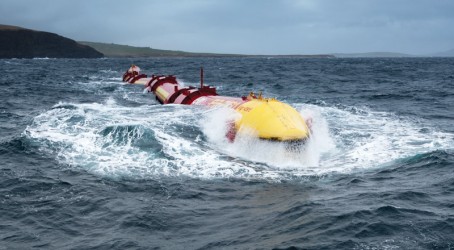Articles
Did you understand what engineering was when you were at school?
No, not really. That’s still true of a lot of people because engineering is not a subject you do at school, so it’s a bit hard to understand what it entails. I was always interested in science and maths and the way the world around me works.
I decided to do engineering because I realised it combined the theoretical side with practical real-world applications. But when I applied to study it at university I wasn’t as aware as I could have been about what it involved.
Where did you study?
I did a masters in mechanical engineering at Edinburgh University, which is a five-year course. A lot of the Pelamis team including Richard Yemm, the company founder, have come through Edinburgh, which has a rich history of wave-power development thanks to Professor Stephen Salter.
That wave-power group has been influential. Salter taught me renewables design in the fifth year, which was inspiring. It was really good to learn from his experience. He’s invented a raft of new devices so there is that inspiration of bringing new things in, which is a rare quality.
What got you interested in working for Pelamis?
I became aware of Pelamis in the third year of university. One of the engineers who works here now was a couple of years ahead of me and she had done a placement at Pelamis. She gave a talk to the students below her about what she was involved with, and I saw it was something special. I worked hard to get a placement here and the rest is history. That was 10 years ago.
What does your role encompass?
I’m a senior engineer involved in the project and business development team. I mix some commercial work with my engineering work. When I first joined, I was involved in pure engineering and I was doing offshore design. I was involved in the development of the Pelamis mooring system.
But then I was brought into a wider role in the business team. So now I mix a bit of the commercial side and a bit of project development: looking at future sites for new technology, and keeping involved in the offshore engineering, which is my area of expertise.
What could be done to encourage more youngsters and women into engineering?
We see a lot of people who go to university to study science and maths who perhaps would have preferred to do engineering had they been more aware of what it involved. So there’s an educational mission at school. I’ve got a big hope that the growth of the renewables sector is something that ought to appeal to all young people, because they have such an interest in positive change. We are seeing more women getting involved in renewables, perhaps not yet on the engineering side, but that could follow.
It’s a new industry. When you look at oil and gas, I think women see it as being male-dominated. But renewables has the opportunity to carve out its own balance.

Switching on to marine energy
Pelamis founder Richard Yemm says that with a wave-energy machine for Scottish Power now on trial “we’re expecting to make rapid progress”. Utilities have been completing development work with Pelamis, drawing on the experience of the first devices to be deployed. The goal is to bring down the cost of electricity generated by the wave-energy machines. The target is £100/MWh.
Yemm says it will be essential that wave energy continues to be supported by the government beyond 2017, the period covered by the Renewables Obligation certificates. The forthcoming energy bill will be crucial, otherwise marine energy may face a “cliff edge”.
“It is a good sign that there is also an appetite among European utilities for wave energy, and there is increasing interest in Japan in the wake of Fukushima,” he says. “The nice thing about Japan is that there is a huge industrial base and also topography that makes onshore wind difficult.”
Offshore wind, meanwhile, has to cope with “very deep water, very quickly. Hence we’re competing with something that is expensive and technically risky, that is, floating offshore wind. That makes Japan an interesting prospect if they are geared up for renewables and the alternatives are constrained.”